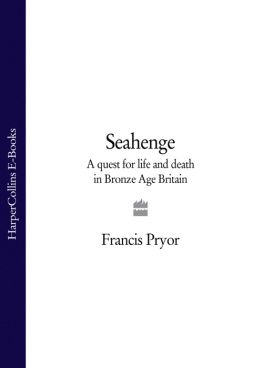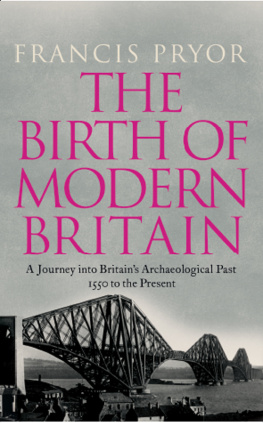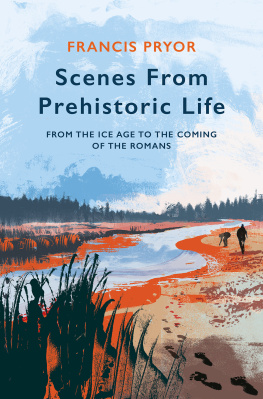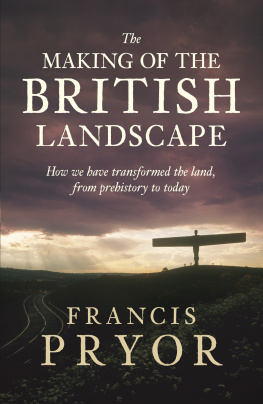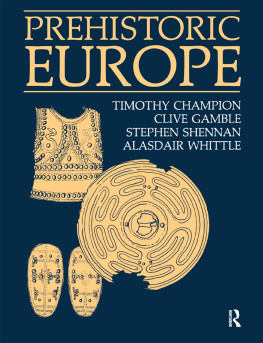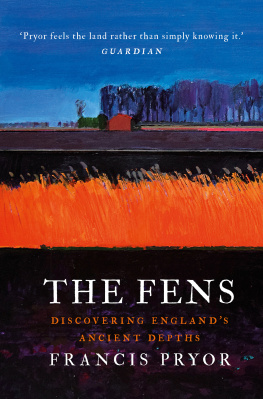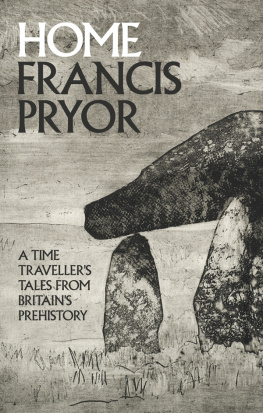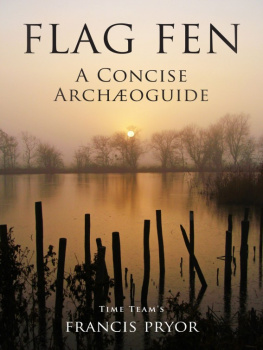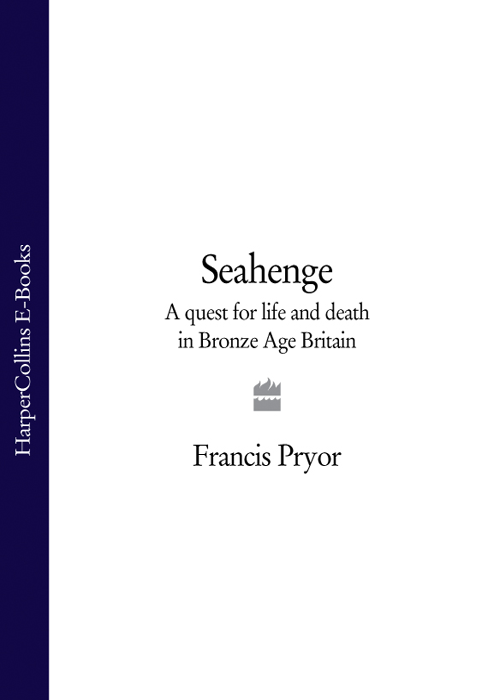SEAHENGE
New Discoveries in Prehistoric Britain
FRANCIS PRYOR

To the memory
of my father-in-law,
DAVID SMITH
Contents
(Unless otherwise stated, all photographs are from the authors collection)
The prehistoric landscape at Fengate, Peterborough. The Bronze Age fields were used by livestock farmers between 2500 and 1000 BC .
Unexcavated Bronze Age droveway ditches at Fengate, showing on the stripped gravel surface as dark marks.
The bank that ran alongside a Bronze Age ditch at Fengate was preserved beneath upcast from a modern drainage dyke.
A minor Bronze Age double-ditched droveway being excavated at Fengate.
Body of a young man buried at Fengate sometime between 3500 and 3000 BC .
Gold objects from Barrow G.8 at Wilsford, Wiltshire (20001800 BC ). (Wiltshire Archaeological and Natural History Society)
Gold grave-goods from a barrow at Little Cressingham, Norfolk (20001800 BC ). (Norfolk Museums and Archaeology Service)
Sheet-gold cape found at Mold, Flintshire, Wales in 1833. It covered a body which lay under a cairn in a gravel pit (20001800 BC ). (British Museum)
The Carnac alignments, erected near the coast in Brittany during the Late Neolithic period, around 3500 to 2500 BC (The Ancient Art & Architecture Collection)
The aerial photograph which first revealed the faint cropmarks of the Etton causewayed enclosure (3800 BC ). (Photo: S.J. Upex)
Corn-grinding stone, or quern, buried on-edge in the Neolithic causewayed enclosure at Etton (3800 BC ).
Aerial photograph taken by J.K. St Joseph in July 1951, showing cropmarks south of Maxey church, Cambridgeshire. ( Crown Copyright 1951/MOD. Reproduced with the permission of the Controller of Her Majestys Stationery Office)
The immediate effects of de-watering on waterlogged Neolithic wood (3800 BC ) at Etton.
The base of a Bronze Age notched log ladder (1000 BC ) found at the bottom of a large quarry pit at Fengate.
The notched log ladder from the Fengate quarry pit.
A notched log ladder in the courtyard of a disused Tibetan Buddhist temple in the Himalayas north of Kathmandu, Nepal. (Photo: Felix Pryor)
Reconstruction of the first Bronze Age roundhouse (c.1500 BC ) to be found at Fengate.
Skeleton of a young woman found at Fengate and radiocarbon dated to 30302500 BC .
Bronze Age weapons (1300900 BC ) from Flag Fen.
Bronze Age wheel found at Flag Fen, dating to about 1300 BC .
Middle Bronze Age stone roadway (12001300 BC ) at Yarnton, Oxfordshire.
Clothes of a young Middle Bronze Age woman (14001200 BC ) found in a barrow at Egtved Farm in southern Jutland, Denmark. (Danish National Museum)
John Lorimer holds the bronze axe that started the Seahenge saga.
A view along the Holme-next-the-Sea peat beds at low tide, autumn 1998, showing the timber circle.
The team from the Norfolk Archaeological Unit start working on the ground-plan of the Seahenge timbers.
A close-up of the post circle, showing the eroded and damaged state of the timbers.
The initial exploratory trench within the circle of timbers, autumn 1988.
Part of the inverted oak tree exposed by the excavation.
A post being prepared for removal.
The teams soil scientist, Dr Fran Green, records the precise position of sample tins placed in the section on either side of a post.
A group of Druids occupy the central tree in an attempt to prevent its removal.
Sheets of foam being attached to the central tree to cushion the straps which would be used to lift it.
The lifting of the central oak tree.
The tree trunk was carefully checked when clear of the ground, in case any votive offering or other unexpected find might still be adhering to it.
Members of the Norfolk Archaeological Unit preparing to lift the final two timbers of the Seahenge circle.
The central tree in a shallow water bath at Flag Fen.
The flat underside of the central oak tree was found to be covered with axe-marks, believed to be the earliest left by a metal tool yet found in Britain. One of the towing loops, still with honeysuckle rope in place, is also visible. (Photo: F. Pryor. Courtesy of English Heritage)
One of the Seahenge timbers being carried to the washing tanks at Flag Fen.
Wide axe-marks, similar to those on the central oak tree, were also found on the lower, chopped ends of the oak posts of the timber circle. (Photo: F. Pryor. Courtesy of English Heritage)
The freshly de-barked oak-tree stump with one of the two towing loops and a length of twisted honeysuckle rope ready for the reconstruction of a full-size replica of Seahenge by Channel 4s Time Team.
The Time Team reconstruction reaches a critical stage, with the oak tree poised above the hole dug to receive it.
The roots of the central oak are levered upwards, and the two-ton tree drops into position.
The tree is manhandled upright.
Aerial view taken during the final stages of the reconstruction.
The interior during the reconstruction.
Excavators working on the Bronze Age religious site at Flag Fen.
An archaeologist reveals part of a wooden axle which had been jammed between two large posts at Flag Fen.
The oak axle from Flag Fen (12001300 BC ), the oldest known axle found in Britain.
Objects thrown into the waters around the Flag Fen posts as offerings to the gods and ancestors.
A later Iron Age village at Cats Water, Fengate, dating to the final three centuries BC .

PREFACE
The Quest
I DECIDED to write a book on prehistoric religion about two years before the discovery in spring 1998 of the site which has since become widely known as Seahenge. My original aim was to demystify the subject, to blow away the fog of romance which so often appears when it is raised. I wanted to show how ancient shrines such as Avebury and Stonehenge were made and used by people who were like ourselves. Although they constructed places of worship that seem remote, alien and strange to us, they themselves were none of those things.
I was fascinated by the outward form the appearance of their religion. Why, for example, did circles play such an important role? Why were offerings placed in the ground? And why were many sites placed within the fields and lanes of the working countryside, while others were hidden away in inaccessible and remote places? We can only attempt to answer these questions if we try to understand the social context of these ancient beliefs; and to do that, we must examine the evidence provided by archaeology.
I also wanted to write about the way in which modern archaeologists can study discarded prehistoric rubbish, long-lost objects and the fragmentary remains of ancient places to recreate the way people thought and behaved. Like fictional detectives, we make deductions from the slightest of clues; but today, increasingly, we go further than that: we try to understand the motives that drove people in the past to construct great monuments like Stonehenge, or small shrines like Seahenge. Almost daily, new scientific techniques are removing the ties that once restricted our imaginations. But these new freedoms carry with them new responsibilities. Its becoming easier to sound authoritative, simply by quoting evidence uncovered by science. To reveal a precise date through some new wonder-technique is one thing, but it is quite another to understand

